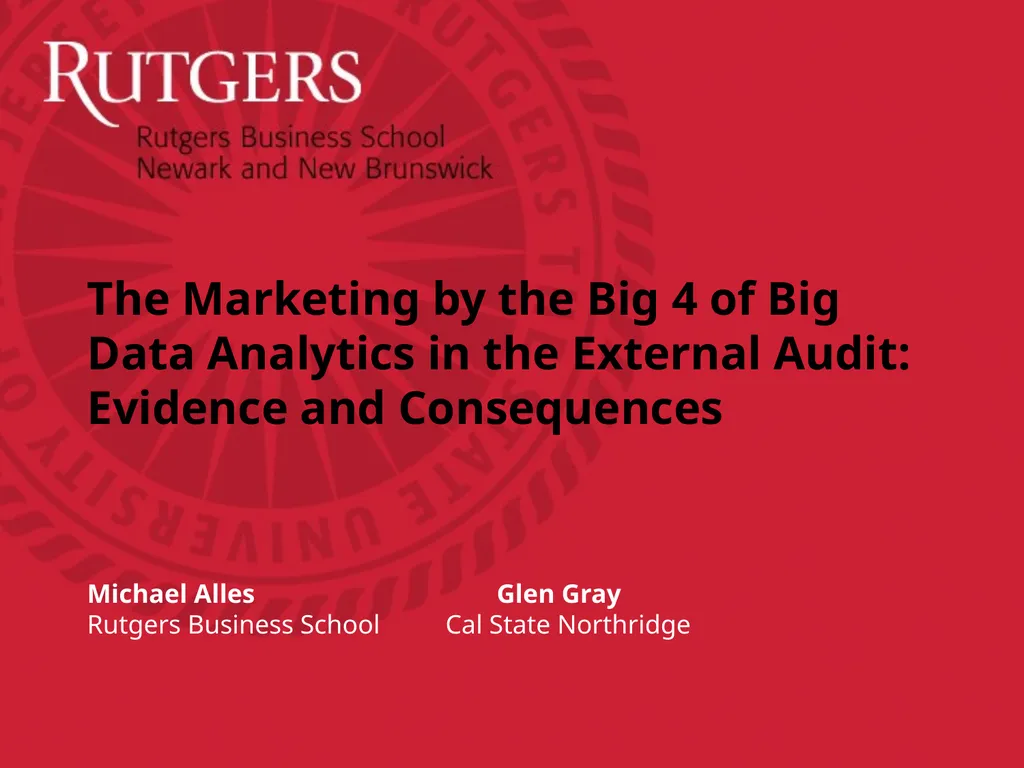Michael Alles Glen Gray Rutgers Business School
Author : natalia-silvester | Published Date : 2025-06-16
Description: Michael Alles Glen Gray Rutgers Business School Cal State Northridge The Marketing by the Big 4 of Big Data Analytics in the External Audit Evidence and Consequences 1 Overview of the presentation This paper aims to make accounting
Presentation Embed Code
Download Presentation
Download
Presentation The PPT/PDF document
"Michael Alles Glen Gray Rutgers Business School" is the property of its rightful owner.
Permission is granted to download and print the materials on this website for personal, non-commercial use only,
and to display it on your personal computer provided you do not modify the materials and that you retain all
copyright notices contained in the materials. By downloading content from our website, you accept the terms of
this agreement.
Transcript:Michael Alles Glen Gray Rutgers Business School:
Michael Alles Glen Gray Rutgers Business School Cal State Northridge The Marketing by the Big 4 of Big Data Analytics in the External Audit: Evidence and Consequences 1 Overview of the presentation This paper aims to make accounting researchers aware of the radically new ways in which the Big 4 audit firms are marketing their audit services and how this will necessitate a fundamental rethink of what an audit is and how it is sold and consumed. What is at stake is the perception of what an audit provides to a client and how it is regulated and undertaken—and taught and researched. Rather than the traditional focus on compliance, audits are being advertised as adding value and insight to the audit client through the application of technology-enabled Big Data Analytics (BDA). 2 What is Big Data Analytics (BDA)? IBM: “Big data analytics is the use of advanced analytic techniques against very large, diverse big data sets that include structured, semi-structured, and unstructured data, from different sources, and in different sizes from terabytes to zettabytes. With big data analytics, you can ultimately fuel better and faster decision-making, modeling and predicting of future outcomes, and enhanced business intelligence.” When applied to the external audit, BDA is a technology-enabled methodology to analyze large amounts of both financial and non-financial data to detect patterns, anomalies, insights, and exceptions. 3 Grounded research and revealed preference Our analysis is based on grounded research into what the Big 4 are saying to their current and potential audit clients, and the principle of revealed preference: that what the firm says is indicative of what they believe and plan to behave. It is important to emphasize that it is the marketing of the assurance arms of the Big 4 that we examine in our paper, not their consulting services. The promotion of BDA, with its goals of adding value and providing insights to the client, is expected when it comes to advisory services but is new and unexpected in the auditing realm. 4 Big 4 no longer resist adoption of technology Deloitte (2016) writes candidly: Audit has not historically been at the forefront of innovation. However, that is changing rapidly. We need to be evolving at the same pace as our clients and our clients are making significant investments in advanced technologies. They expect our audits to keep pace. Today, all the Big-4 tout their extensive use of technology,














